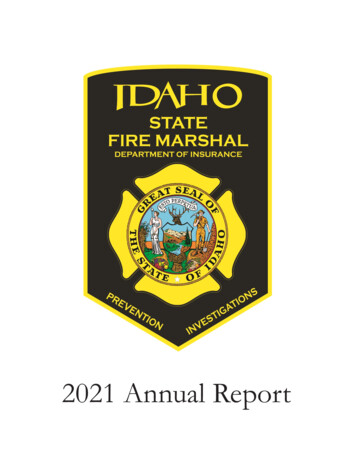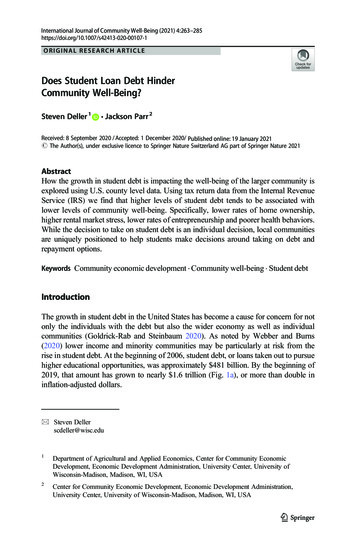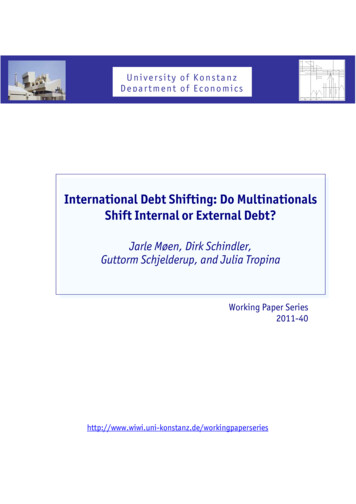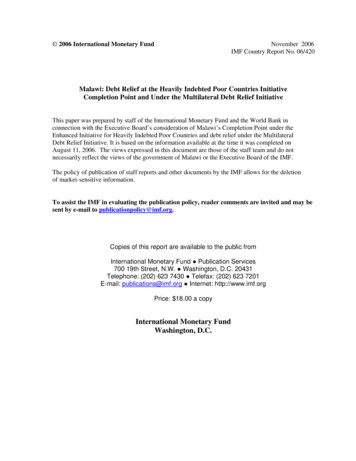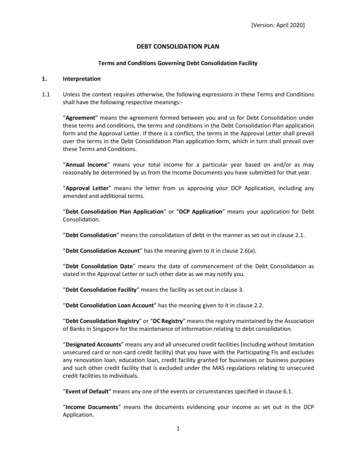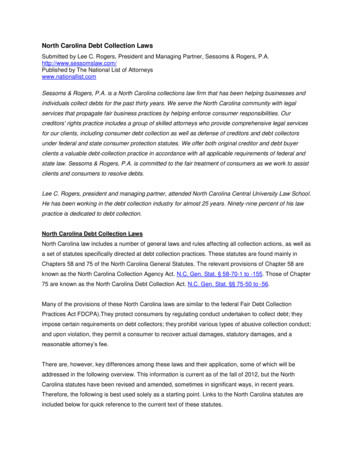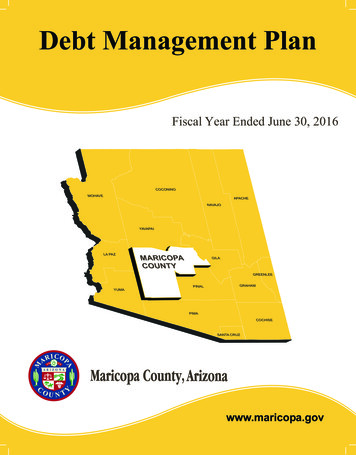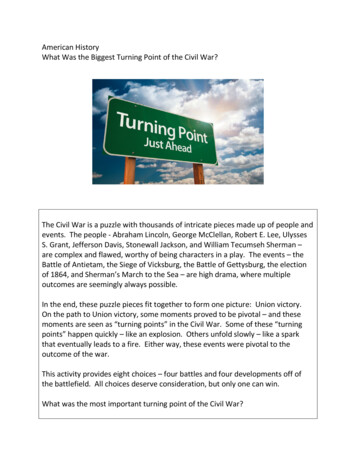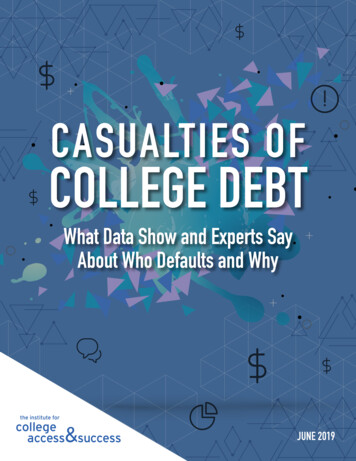
Transcription
CASUALTIES OFCOLLEGE DEBTWhat Data Show and Experts SayAbout Who Defaults and WhyJUNE 2019
ACKNOWLEDGEMENTSThe Institute for College Access & Success (TICAS) is an independent, nonprofit, nonpartisan organizationworking to make higher education more available and affordable for people of all backgrounds. To learnmore about TICAS, visit ticas.org and follow us on Twitter at @TICAS org.Casualties of College Debt: What Data Show and Experts Say About Who Defaults and Why was written byLindsay Ahlman with substantial contributions from Veronica Gonzalez.We would like to thank the many experts and students who were generous in sharing their knowledge andexperience with us.We are grateful to the Bill & Melinda Gates Foundation whose support made this project possible. The viewsexpressed in this paper are solely those of TICAS and do not necessarily reflect the views of our funders.This report can be reproduced, with attribution, within the terms of this Creative Commons .PAGE 2CASUALTIES OF COLLEGE DEBT: WHAT DATA SHOW AND EXPERTS SAY ABOUT WHO DEFAULTS AND WHY
TABLE OF CONTENTSIntoduction4On the Brink: Who Is Delinquent But Not (Yet) In Default?5Over the Edge: What Happens When a Borrower Defaults, and Who Defaults?6Expert Perspectives on Who Defaults and Why10Life Gets in the Way: The Role of Other Financial Hardships10Caught in the Web: The Role Overly Complex Systems and Processes Play in Default12Missing Tools in the Toolbox: Gaps in Information and Support13Recommendations16Conclusion191314THE INSTITUTE FOR COLLEGE ACCESS & SUCCESSPAGE 3
IntroductionEach year, about seven million students invest in their futures by taking out federal loans to go tocollege.1 For most, these loans will prove a worthwhile investment. Borrowing enables millions ofstudents to enroll in college and to complete more quickly. The returns to college remain high, andmost students successfully repay their federal loans.However, there are clear and urgent signs of repayment distress for student borrowers who – while notthe majority of all borrowers – still number in the millions. A quarter (24%) of all Direct Loan borrowerswere either delinquent or in default at the end of 2018,2 and in the last 12 months alone, over a millionDirect Loan borrowers entered default.3Certain groups of students are particularly likely to struggle with student debt. Low-income students,Black students, and students earning four-year degrees at for-profit colleges are more likely to borrowand to borrow more than their peers.4 They are also more likely to default.5 Older borrowers, thosewho attend part-time and attend non-selective schools, and who leave school without a certificateor degree are more likely default, even though they often have small loans.6 Furthermore, thepossibility that as many as 70 percent of Black borrowers may eventually default is deeply troublingand underscores the urgent need to reduce default to address persistent racial inequities in highereducation outcomes.7Student loan defaulters are not the only borrowers feeling the effects of their debt long after college.Some borrowers are successfully repaying their loans but at the cost of delayed homeownership andless ability to save for retirement. Others remain in good standing on their loans but see the amountthat they owe continue to grow because their income-based payments are smaller than their accruinginterest. However, this report focuses specifically on the worst student loan outcome, shared bymillions of students: default.Borrowers default on a loan when they fall at least 270 days behind on their loan payments, and theself-defeating, sometimes overly punitive, and long-lasting consequences of default make it a sourceof vital concern for policymakers focused on improving both higher education attainment and theeconomy.For decades, policymakers have sought to make student loans more affordable by reducing interestrates, creating new repayment plans, and allowing students to defer repayment. While the existingconsumer protections for federal student loans remain vital, we must do more to ensure studentswho borrow do not end up worse off for pursuing their education and career goals. Meanwhile, whileavailable data can shed light on the scope and scale of delinquency and default, we know too littleabout the lived experience of default, including how and why borrowers fall into default, how they getout of default, and both the immediate and long-term impact of default.To understand better the experience of student loan default, and what policy changes are most likelyto help borrowers, we sought the perspectives of student loan policy experts, researchers, servicers,and the legal aid practitioners helping borrowers resolve default. We also looked to the latest federaldata on delinquency and default to shed needed light on who defaulted borrowers are, and spokewith several borrowers who have defaulted to learn more about the lived experience of default.8PAGE 4CASUALTIES OF COLLEGE DEBT: WHAT DATA SHOW AND EXPERTS SAY ABOUT WHO DEFAULTS AND WHY
This report explores the key themes of who defaults and why that emerged across over 20 in-depthconversations and lifts up the lived experience of default though voices of borrowers themselves.Borrowers who default on their student debt often struggle with severe overall financial hardshipat the same time that they are expected to navigate a complex federal loan repayment systemwith limited resources, imperfect information, and inadequate assistance. The data also clearlyshow that borrowers who default are largely the same group of students who entered schoolwith disproportionate barriers to college success, further underscoring not only the devastatingconsequences of default for individuals but also its consequences for state and national goals toincrease educational attainment and close equity gaps.Following an exploration of the data and a summary of key insights from experts, we makerecommendations for immediate policy improvements to reduce financial hardship by streamliningand strengthening income-based repayment, and identify priority areas for further study and actionto reduce default.On the Brink: Who Is Delinquent But Not (Yet) In Default?Missing a student loan payment is an early sign of borrower distress. Borrowers become delinquentimmediately after missing a single payment, and remain delinquent until they either pay the pastdue amount or make alternative repayment arrangements (for example, by placing loans in atemporary repayment relief). Borrowers who are delinquent for more than 90 days will see theircredit scores negatively impacted, and after 270 days of failing to make required payments, aborrower defaults.U.S. Department of Education dataon the state of the federal loanprogram portfolio provide someinsight into who struggles to repaytheir loans and are at greatest riskof default. Among borrowers atleast 31 days delinquent at the endof 2018, almost half (45%) are 35years or older.9 Delinquency is alsoassociated with where a borrowerwent to school: those who attendedfor-profit schools are more likely thantheir peers at public or non-profitschools to be delinquent.10THE INSTITUTE FOR COLLEGE ACCESS & SUCCESSPAGE 5
Leaving school without a credentialis also associated with higher ratesof delinquency. Over half (54%)of borrowers at least 31 daysdelinquent never completed theirprogram.11 As shown in the graphto the right, borrowers who leaveschool without a credential are overtwice as likely to be delinquent.12By providing the option of monthlypayments calculated as a share ofincome rather than a fixed amount,income-driven repayment (IDR)plans play a critical role in reducinga borrower’s risk of delinquency.Borrowers repaying Direct Loans ina standard 10-year repayment planare more than four times as likely to be 91 or more days delinquent than borrowers enrolled inthe two most recently offered IDR plans (13% vs. 3%).13 Research on the causal effects of IDRenrollment has shown that borrowers enrolled in an IDR plan are less likely to be delinquent,and they pay down more of their loan each month than those in fixed plans with similar level ofengagement with their servicers. This is true even though monthly payments can be smaller inIDR than in a fixed repayment plan because they are less likely to miss payments.14Over the Edge: What Happens When a Borrower Defaults, and Who Defaults?Default is the most devastating possible student loan outcome. It adds significant costs to aloan and can create compounding financial hardship. Upon entering default, the entire unpaidbalance (including accumulated interest) becomes due. To collect unpaid debt, the federalgovernment can garnish a defaulted borrower’s wages, as well as withhold tax refunds andother federal benefit payments.“Having them take my tax refund last year has thrown me into the red every singlemonth since then because that was my catch-up fund. That was my money that wasactually going to pay my landlady and enable me to get ahead a tiny bit. I havenothing in retirement, and probably never will. This system perpetuates itself.”Collections fees are also charged, and can be in excess of what a borrower would haveotherwise paid had they not defaulted. Those costs can also vary depending on how aborrower resolves the defaulted loan; prior research estimates that the collection costs for a 7,000 defaulted loan balance can range from 0 to over 2,000 depending on the type ofPAGE 6CASUALTIES OF COLLEGE DEBT: WHAT DATA SHOW AND EXPERTS SAY ABOUT WHO DEFAULTS AND WHY
default exit.15 None of these amounts are clearly based on actual collection costs incurred by thefederal government.A defaulted student loan also adversely effects a borrower’s credit score, making other financialinvestments either impossible or more costly, and can jeopardize both living arrangements andemployment.“I have awful credit. That’s the worst. People think you’re a deadbeat.”In addition, a range of other punitive consequences make returning to school or securingemployment more difficult. These include the loss of eligibility of future federal financial aid,the inability of defaulted borrowers to secure academic transcripts from their prior schools, andineligibility for certain professional licenses in more than a dozen states.16 And beyond the tangibleconsequences of default, the experience can be psychological devastating.“I was in a constant driven panic for six years. You can’t move, you literally cannot function.”“They were making it so that I could not think beyond my pool of debt. It was interfering with my ability to function in myworld.”Available data do not shed light on howoften borrowers experience each of theseconsequences, and their impact on borrowersin financial distress is unavailable. However,data from a nationally representative survey ofstudents who began college in 2004 shed somelight on who defaulted borrowers are.17 Themajority (65%) of borrowers who default within12 years of starting college entered schoolwith incomes below 200 percent of the federalpoverty level for their family size.18 Just overhalf (51%) have dependent children. Defaultedborrowers are two and half times more likely tobe single parents (20% vs 8%), twice as likelyas non-defaulters to have been independentstudents (40% vs 20%), and one and a half timesmore likely to be first-generation students (47%vs 30%). Defaulted borrowers are also over twoand half times more likely to have attended afor-profit school than non-defaulters (45% vs17%). And consistent with a growing body ofTHE INSTITUTE FOR COLLEGE ACCESS & SUCCESSPAGE 7
research identifying the disproportionate risk of default facing Black borrowers,19 defaulters are alsoover twice as likely as non-defaulters to be Black (33% vs 14%).Perhaps counterintuitively, borrowers with higher debts are not at a higher risk of default.20 Over half(52%) of borrowers who default within 12 years of entering college have undergraduate federal loanstotaling less than 10,000. In fact, borrowers with less than 10,000 in federal undergraduate loans areabout 50 percent more likely to experience default than those with total debt of at least 10,000 (34%vs 23%).21Higher debt is correlated with the length of time in school and degree completion, including andup to graduate and professional degrees. While these borrowers may have higher debt, they alsoreceive higher financial returns to their education that enable repayment.22 Meanwhile, the relationshipbetween lower debt amounts and default is in large part related to the fact that borrowers who leaveschool before completing a program spend less time in school, and therefore borrow less. They mayleave with less debt, but doing so without a completed credential increases their risk of default twofold.23 Half (49%) of defaulted borrowers never complete their program, and many experts we spoke topointed to a lack of credential being a major factor in default.The relationship between completionand default is symptomatic of a cycleof hardship facing students who, fromthe outset, face the most barriers tosuccess. Specific groups of studentsare both less likely to completetheir program and more likely toexperience default. For example, just43 percent of low-income studentsreceiving a Pell Grant earn a certificateor degree within five years, comparedto 57 percent of their higher-incomepeers. At the same time, Pell Grantrecipients are almost twice as likelyto borrow and over three timesmore likely to default within 12 yearsthan non-Pell recipient peers (79%versus 44% and 35% versus 11%respectively).Students who are single parents, Black, first generation, independent, and who have family incomesbelow 200 percent of the federal poverty level (FPL) are all less likely than their peers to graduate andmore likely to default. Many of these students are also more likely to borrow.PAGE 8CASUALTIES OF COLLEGE DEBT: WHAT DATA SHOW AND EXPERTS SAY ABOUT WHO DEFAULTS AND WHY
Borrowing, Completion, and Default among Vulnerable Students24Pell GrantRecipientSingle ParentBlackFirst GenerationIndependentFamily IncomeBelow 200% FPLYESNOYESNOYESNOYESNOYESNOYESNO% Borrowed79%44%66%*63%77%61%62%*64%57%66%68%59%% Completed in5 Years43%57%27%52%37%52%41%55%33%56%41%56%% Defaulted in12 Years35%11%50%25%48%23%38%22%44%22%41%17%While failure to complete is clearly broadly linked with an increased risk of default, for somegroups of borrowers the likelihood of default can remain relatively high even when they finish theircertificate or degree. For example, Pell Grant recipients and Black students who complete theirprograms are both more likely to default than their non-Pell recipient and non-Black peers who donot complete. And students who earned a certificate or degree from a for-profit college are morelikely to default than students who dropped out of a public of non-profit college.25Some analysts have suggested that borrower regret and resentment (for example, as a resultof earning a low quality credential that falls short of providing a path to securing employment)may contribute to an unwillingness to repay related loans.26 While students who were misledinto enrolling in or otherwise mistreated by their college are entitled to have their federal loansdischarged, some experts with whom we spoke suggest that other students – particularly thosewho leave school with debt but no degree – may similarly regret borrowing or even their decisionto go to school in the first place.“I never would have gone to college, because I’m in no better place. In fact,financially and emotionally, I’m in a worse place now than when I started school.”Other experts we spoke with believe that, while borrowers may hate feeling like they did notrealize the expected returns from their investment, resentment doesn’t factor into any decision torepay a loan or not. Rather, borrowers keep repaying to the extent they have resources to do so.THE INSTITUTE FOR COLLEGE ACCESS & SUCCESSPAGE 9
272829BORROWER DEFENSE: A LEGAL REMEDY FOR DEFRAUDED BORROWERSThe “borrower defense to repayment” rule protects borrowers who were cheated bytheir colleges. Created in 1994, the rule authorizes the Department of Education toforgive Direct Loans that were connected to illegal actions of their colleges, such asfraud or breach of contract.The rule was little-noticed and rarely used for years. In 2015, a national chain of forprofit colleges, Corinthian Colleges, abruptly closed in the wake of findings thatthey had mislead prospective students on job placement rates. On the basis of thesefindings, the Department developed a process for processing and adjudicating theseclaims and finalized a new regulation setting out a more clear and transparent processfor borrowers to assert a defense to repayment. Since 2015, nearly 200,000 borrowersfrom Corinthian and other colleges have applied for relief.27Under a new administration, the Department of Education has moved slowly to processthese claims, and there are 158,000 applications under review as of December 31,2018.28 It is also midstream in writing new regulations that will apply to new studentloans which would, according to the Department’s own estimates, provide relief to avery small share of students cheated by their colleges.29Expert Perspectives on Who Defaults and WhyLife Gets in the Way: The Role of Other Financial HardshipsThe reality that life and other financial hardships get in the way of being able to repay student loanswas a consistent theme in our conversations with student loan policy experts, researchers, servicers,and the legal aid advocates who work with student borrowers. According to these experts, those indefault are almost always facing other challenges, such as drops in income, health issues, or otherforms of debt that could also be in collection and further straining resources. Experts tell us that itis common for defaulted borrowers to be receiving some form of public assistance. Some defaultedborrowers are living paycheck to paycheck, while others have no stable source of income at all. Ourconversations with defaulted borrowers also underscored that other financial hardships were a keydriver in why they defaulted.The federal student loan program attempts to address some of these problems. Federal loanborrowers in financial distress may be eligible for temporary repayment relief through deferment andforbearance options. Deferments due to economic hardship or unemployment are not uncommonamong all borrowers, but a higher share of defaulted borrowers use this option: One in four ofborrowers who default have a prior deferment due to economic hardship or unemployment, comparedto one in five non-defaulted borrowers.30 Defaulted borrowers are also more likely to have ever usedforbearance (69% of borrowers who defaulted, compared to 52% of borrowers who did not).31PAGE 10CASUALTIES OF COLLEGE DEBT: WHAT DATA SHOW AND EXPERTS SAY ABOUT WHO DEFAULTS AND WHY
IDR plans also provide a critical safety net for borrowers facing financial hardship by calculatingmonthly payments as a share of annual income. However, the formula for calculating paymentscannot account for unexpected or ongoing expenses that exceed the basic living allowanceprovided to everyone in IDR. Additionally, monthly payments in IDR do not take into accountamounts owed on private education loans.We do not have enough information or data to understand fully why borrowers may default evenwhen the temporary relief options offered by deferment or forbearance and longer-term optionsof reduced monthly payment amounts offered by IDR are available. However, some of the expertswe spoke with emphasized that distressed borrowers may be struggling to pay for food, the nextmonth’s rent, or gas or car repairs needed to get them to work. The borrowers we spoke to alsohighlighted the hardship of facing these tradeoffs.“Student loans were lower priority than other things. I needed shelter and food. Andto take care of my kids.”“What really pushed me is just extreme poverty. My husband owned a business and hehad a heart attack, and we lost our house to foreclosure. I had medical issues, he hadmedical issues.”“I was losing my house, I couldn’t find work I didn’t have money to get in my car togo get gas I was getting six phone calls every day on my house. And then they wantme to mess with the student loans, I felt like I was in a war zone. It was insane.”“What are they going to do with me? I don’t have anything left. I have no assets. Idon’t have a job, I have no income.”Facing resources already stretched thin, we heard from both borrowers and those that assistthem that the stress of loan payment obligations on top of other sources and symptoms offinancial distress can be overwhelming and demoralizing. As student debt has become the norm,researchers and others have paid increasing attention to the psychological consequences ofpersistent student debt.32 It is not only borrowers facing immediate and critical needs who strugglewith the psychological impact of student debt. For some, monthly student loan payments comeat the expense of making other investments like home purchases or starting a business, creatinglong-term distress and discouragement. We also heard from experts who work with borrowers thatwatching a loan balance grow while making required payments (a state of ‘negative amortization’that results from monthly payment requirements that fall short of covering monthly interest accrual)can leave borrowers feeling hopeless, anxious, guilty, and ashamed. These psychological impactsassociated with repaying student debt are not easily quantifiable, but they are familiar to expertsand also echo findings from previous borrower focus groups.33While federal repayment policy attempts to address some of these concerns, even the bestdesigned policy can face implementation issues that undermine good intentions. Dischargingfederal student debt that remains after a set period of repayment (20 or 25 years in current IDRplans) is meant to help allay concerns about ballooning loan balances that persistently low-incomeTHE INSTITUTE FOR COLLEGE ACCESS & SUCCESSPAGE 11
borrowers may face in IDR. However, conversations with experts who work with struggling borrowerssuggest that two or more decades can feel out of reach for many borrowers. Furthermore, any amountforgiven for borrowers enrolled in IDR will be taxed as earned income, which can lead to a costly taxbill (described by one expert as a “tax bomb”) at the moment borrowers are intended to experiencerelief.34 Meanwhile, the Public Service Loan Forgiveness (PSLF) program offers a shorter path toforgiveness for qualified borrowers, and amounts forgiven through PSLF are not subject to taxation.Yet widely visible implementation problems– and fears of the program being eliminated – continueto bring stress and fear to borrowers hoping to receive relief after making the required ten years ofpayments.35PRIVATE LOANSMore than a third (38%) of borrowers who default within 12 years have a private (nonfederal) loan.36 Private loans are one of the riskiest ways to pay for college and offerfewer consumer protections than federal student loans. Payments on private educationloans are not factored into the calculation of ‘affordable’ monthly federal loan paymentsbased on income and therefore are layered on top of that obligation. Carrying multipletypes of loans, each with different options for relief and degrees of flexibility duringperiods of financial hardship, and multiple servicers compound all of the challengesfacing struggling borrowers.Caught in the Web: The Role Overly Complex Systems and Processes Play in Default36The sheer complexity of the system borrowers must navigate to repay their debt is hard to manage,especially for those also dealing more generally with unpredictable expenses or insufficientincome. Borrowers have an array of repayment plan options, each of which have variable eligibilityrequirements and varying benefits.37 In addition to three options providing fixed monthly payments,there are five IDR plans. These plans provide flexible monthly payments based on income and familysize, and provide forgiveness of any debt remaining after 20 or 25 years of repayment. IDR providesa critical safety net for struggling borrowers, and the Department of Education provides repaymentselection tools to help borrowers identify a qualifying plan that will provide the lowest monthlypayment. However, the array of similar but somewhat different plans adds unnecessary complexity forborrowers and servicers.Many of our conversations also highlighted the requirement that borrowers annually recertify theirincome in order to remain enrolled in IDR as especially problematic. Missing this deadline can resultin a sudden and unaffordable spike in payments, and previous Department data shows over half ofborrowers miss their annual recertification deadline.38Deferment and forbearance options are also complex. Experts agree that these options are a shortterm term benefit that borrowers should only use for discrete, temporary hardships because of theirPAGE 12CASUALTIES OF COLLEGE DEBT: WHAT DATA SHOW AND EXPERTS SAY ABOUT WHO DEFAULTS AND WHY
temporary nature and associated interest costs. Depending on the type of loan, deferment may ormay not pause interest accrual; most students will see interest continue to accrue for some loansbut not others. There are also a number of types of forbearance, some of which servicers havediscretion in granting. All loans in forbearance accrue interest and, depending on the type of loan,that interest may or may not capitalize at the end of the forbearance period.39The complexity of student loan repayment continues at default. After defaulting, borrowersseeking a way out face a maze of options for getting their loans back to good standing, eachof which come with different requirements, costs, and benefits.40 Defaulted borrowers canresolve their loans by rehabilitating the loan through making nine consecutive payment amountsestablished by their collector, by consolidating them into a new Direct Consolidated Loan, or bypaying their debt in full. Borrowers whose wages are being garnished as a result of default are noteligible for consolidation, and a record of default will remain on their credit history. Prior researchsuggests as many as 70 percent of defaulted borrowers exit default within five years.41 However,the variable options and corresponding costs and consequences of different paths to exitingdefault can make the process difficult to navigate without assistance.“It shouldn’t be so difficult that a person needs legal assistance like I got. I am lucky thatit was pro bono.I’m not sure that I could have afforded that. I am sure the legal billingwould have been more than what I got back.”Missing Tools in the Toolbox: Gaps in Information and SupportAnother common theme we heard in our conversations with borrowers, servicers, and practitioners,was that borrowers are navigating the complex repayment system with both imperfect informationand inadequate support.All federal student loan borrowers are currently required to complete loan counseling at only twopoints in time: when they first take out a loan (“entrance counseling”) and when they graduateor leave school (“exit counseling”). While better information is not a solution to inadequatefinancial resources, the current federal student loan counseling requirements fall short of providingborrowers with adequately timely information that is needed to prepare students for successfulrepayment. As designed, exit counseling may be particularly poorly timed, as well as inconsistentlydelivered. Students who leave school without completing their program– and who are thereforeat higher risk of default – may be the least likely to have recently received the information aboutrepayment they need.While timelier loan counseling can help ensure borrowers have the information they need,these interventions are no substitute for responsive, just-in-time support that may be neededwell into repayment when financial hardship arises. Student loan servicers are best positionedto provide this support, but even well intentioned efforts may fall flat if borrowers are otherwiseoverwhelmed, fear servicers rather than see them as a source of potential support, or cannotrely on the information servicers provide. Distrust of servicers may be legitimately rooted in priorbad experiences, such as incorrectly processed paperwork or communication of insufficient orinaccurate information.42THE INSTITUTE FOR COLLEGE ACCESS & SUCCESSPAGE 13
RETURNING TO DEFAULTAfter exiting default, many “re-defaulters” soon return to it. A 2016 report fromthe Consumer Financial Protection Bureau estimated that one in three rehabilitatedstudent loan borrowers will return to default within just two years, in large part due toinadequate servicing and punitive collections practices.43 As of September 30, 2017,nearly one in 10 Direct Loan borrowers who entered default during the preceding 12months had defaulted on a loan that was previously rehabilitated.44 Better informationabout why and how this subset of borrowers re-enter default after having successfullynavigated out of it might shed important light on the most stubborn barriers to reducingand eliminating default.Struggling borrowers often find themselves granted consecutive forbearances by their servicer,even if enrollment in IDR would be a better option for them. Servicers responding to request forrepayment relief may or may not adequately or consistently inform borrowers of their options as wellas the relative pros and cons of deferment, forbearance, and enrollment in IDR. Even in cases whereservicers do provide this information, facing multiple options, each with different consequences, mayimpede borrowers’ ability to fully under
temporary repayment relief). Borrowers who are delinquent for more than 90 days will see their credit scores negatively impacted, and after 270 days of failing to make required payments, a borrower defaults. U.S. Department of Education data on the state of the federal loan program portfolio provide some insight into who struggles to repay
